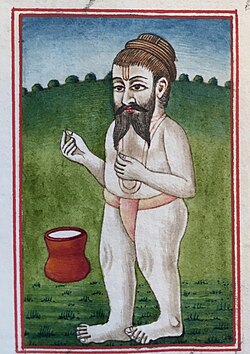AJAT SAGAR, by Surjan Das Ajat, is the religious book of the Ajatpanthi sect of the Udasis. Written in AD 1851, the only known manuscript of the work was available in the Sikh Reference Library, Amritsar, until it perished during the Blue Star action in the holy premises in 1984. The author Surjan Das (father: Bagh Singh, mother: Gulab Devi, a disciple of Sant Tahil Das who was in the Bhagat Bhagvanie sect of the Udasis, established his gaddi at Ajneval, in Gujrariwala district, now in Pakistan. Surjan Das preached the ideal of a casteless (a = without; Jat = caste) society and thus came to be called Ajat and his followers Ajatpanthi.
Another of his works was Surjan Bodh which is held in the Panjab University Library, Chandigarh, under MS. No. 111. The poetry of Surjan Das is uneven, though he tries to keep close to the gurbani idiom. Transience of the world, man`s forgetfulness of God and the importance of nam are the principal themes of Ajat Sagar. Guru Nanak has been depicted in this work as “the destroyer of evil.”
References :
1. Randhir Singh, Bhai, Udasi Sikhan di Vithia. Chandigarh, 1972
“Ajat Sagar” is a fascinating and historically significant manuscript that once served as the cornerstone of the Ajatpanthi sect within the Udasis. Authored by Surjan Das Ajat in 1851, it was not merely a piece of religious literature but also an impassioned call for a society free from the rigid confines of the caste system. In his writing, Surjan Das challenges established norms by articulating a vision of unity that transcends the traditional barriers defined by birth and social stratification.
The manuscript’s poetic verses delve into the transient nature of worldly life and the profound human tendency to forget the divine presence. One of its unique features is the portrayal of Guru Nanak as “the destroyer of evil,” which adds a powerful dimension to its spiritual message. Beyond its theological insights, “Ajat Sagar” encapsulates the cultural and social ethos of its time—reflecting both a critique of societal divisions and an optimistic blueprint for a more egalitarian future. Its loss from the Sikh Reference Library in Amritsar during the tumultuous events of Operation Blue Star in 1984 represents not only the disappearance of a valuable religious text but also a poignant reminder of how political strife can erase treasured cultural heritage.
This manuscript continues to resonate deeply with scholars and spiritual seekers alike. Its themes of social equality and the importance of divine remembrance offer timeless reflections that invite us to reexamine modern societal structures. The legacy of “Ajat Sagar” prompts us to consider how lost texts, often rediscovered or reimagined through secondary references, shape our understanding of religious thought and cultural identity.



